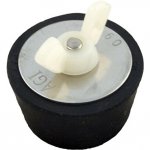Hi all,
Thanks again so much for helping me through the whole TFP method process. The pool has been great this summer - just dumping some bleach into it here and there. Love it!
The time has come to close our NY pool up, now that the water temp is consistently below 60º. At: Pool School - Closing an In Ground Pool I read that he lowers the water level 4" below the return jets. Last year (pre-TFP) I paid a pool shop to close the pool for me and they didn't lower the water level at all, and screwed a gizmo in the skimmer.
So my questions are: couldn't the pool's freeze/thaw cycle damage the concrete sides of the pool? That's the point of the gizmo, correct? (To relieve pressure on the sides of the pool and have the gizmo take it instead.) If the water level is below the returns, won't that defeat the purpose of the gizmo? Or is the gizmo's primary function just for the skimmer compartment? (And not the entire body of the pool?)
Also, is polyquat really needed for New York state pools? Seems like it would be more important in southern pools where the water temp is above 60 during winter months where algae can grow easier?
Edit: also, do you even bother blowing out the floor drain? Or for the floor drain do you just dump antifreeze into the pipe until it overflows?
Thanks a bunch!
-Gary
Thanks again so much for helping me through the whole TFP method process. The pool has been great this summer - just dumping some bleach into it here and there. Love it!
The time has come to close our NY pool up, now that the water temp is consistently below 60º. At: Pool School - Closing an In Ground Pool I read that he lowers the water level 4" below the return jets. Last year (pre-TFP) I paid a pool shop to close the pool for me and they didn't lower the water level at all, and screwed a gizmo in the skimmer.
So my questions are: couldn't the pool's freeze/thaw cycle damage the concrete sides of the pool? That's the point of the gizmo, correct? (To relieve pressure on the sides of the pool and have the gizmo take it instead.) If the water level is below the returns, won't that defeat the purpose of the gizmo? Or is the gizmo's primary function just for the skimmer compartment? (And not the entire body of the pool?)
Also, is polyquat really needed for New York state pools? Seems like it would be more important in southern pools where the water temp is above 60 during winter months where algae can grow easier?
Edit: also, do you even bother blowing out the floor drain? Or for the floor drain do you just dump antifreeze into the pipe until it overflows?
Thanks a bunch!
-Gary


